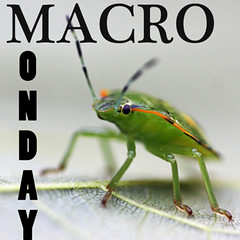For a kid, getting acquainted with a new toy is so much fun. For me having a new toy is seeing the new perspectives with the ordinary things I often ignored, nor didn't know exist. Having a macro lens as a new toy gave me more insights, more awareness and more information. I am inclined now to patiently wait for a very small insect to surface prominently, or to allow it go to a nicely colored background. I didn't know there are very small insects which visit a particular flower. In the past I've always been trying to follow the butterflies, the mantis, the bees. The butterflies challenged me before in learning their identifications. This time, I guess the small insects are more difficult to identify. But they are so intriguing, and I get really very curious with their habits and characteristics.
Dewdrops have been more meaningful now as well, as I don't get so frustrated anymore in not being able to get a good shot using a telephoto lens.
I can now limit my depth of field to a better background blur.
This is not possible before with my telephoto lens, and i take lots of photos to get a similar result. That is because my hands are not steady anymore after long hours holding a heavy camera, and tripods are not my favored companions. The above is an asparagus fern. It has some berries which will eventually become green and then red when ripe.
I have not been so mindful of the lovely shape of this Impatiens balsamina flower bud before. I just noticed it after getting the macro lens.
This is the fully opened flower of the Impatiens balsamina. This is the stage which always attracts my attention, just like the common insects which favor it.
I've always been taking the whole drooping inflorescense of this Heliconia rostrata. I agree, the whole inflorescense is really beautiful, but I am glad to show its other characteristics. The real flower protrudes at the ends of the very colorful bracts. It is at this portion where the insects congregate getting the nectar.
Above is a ~3mm long beetle on a Turnera ulmifolia flower. I've waited a long time for it to leave the center of the flower and be on the side to get a different colored background. I was a bit impatient earlier, I prodded it to move a bit sideways from the center. It was frustrating, as instead of moving just a little outward it flew away. So when i found this one, i just waited for it to move on its own. Isn't it more beautiful this way!
...and this is a marigold bud!















![Outdoor Wednesday logo_thumb[1]](https://blogger.googleusercontent.com/img/b/R29vZ2xl/AVvXsEirBEadwLCRF3TGhXr9kLikVfPCyVYCAbmEcAbSJxvZHZcvJv4UrAyDUGGAl_4NfglKgXJpQOT1JvvqQtJ_qo3WkmUiaDZsDQKMrwba6NA4l5G17XrhMx44hjfRmRC_mKd1fbqnUpjb9kc/?imgmax=800)







































